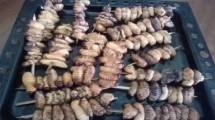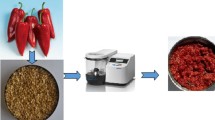Abstract
Four supplement mixtures using whole wheat, pearl millet, bengal gram, green gram, groundnuts and amaranth leaves were developed employing roasting and malting techniques. Malting used in the formation of the supplements reduced significantly hot paste viscosity of all the four supplements and increased their nutrient density per unit volume. The results of organoleptic trials conducted on rural mothers revealed that taste, texture, colour, aroma, appearance and overall acceptability of all the four supplements were excellent with mean scores of overall acceptability (9.77, 9.33, 9.11 and 8.75) for supplements I, II, III and IV, respectively. Children did not develop any GIT disorders after consuming the products. Trained panelists found all the four supplements acceptable as indicated by Nine point hedonic scale.
Similar content being viewed by others
References
Chandrasekhar V, Devadas RP (1986) Clinical impact of low cost indigenous foods on children. Rec Adv Clin Nutr 2: 349–353.
Desikachar HSR (1980) Development of weaning foods with high calorie density and low hot paste viscosity using traditional technology. Fd Nutr Bull 2: 21–23.
PAG (1976) Protein Advisory Group — Nutrition Document R. 10 Add. 91/Rev. WHO/FAO/UNICEF Meeting Geneva. United Nations, New York, pp 1–11.
Khan, N, Zaman R, Elahi M (1998) Effect of processing on the phytic acid content of Bengal gram (Cicer arietinum) products. J Agric Fd Chem 36: 1274–1276.
Nayak VR (1983) Studies on roasted, malted and combinations of roasted and malted mixes with respect of viscosity recipe formulation, acceptability and shelf life. Report of a workshop on weaning foods. New Delhi: Unicef, Regional Office for South Central Asia.
Tara Gopaladas (1988) Simple traditional methods for reducing dietary bulk of cereal based diets in rural homes. Proc Nutr Soc India 34: 112.
ICMR (1970) Studies on preschool children. Report of the working party of the Indian Council of Medical Research Tech Rep Ser No. 26.
Snedecor GW, Cochran WG (1967) Statistical Methods. Ames: Iowa State University Press.
Malleshi NG, Desikachar HSR (1986) Reducing the paste viscosity (dietary bulk) of roller dried weaning foods using malt flour or fungal amylase. J Fd Sci Technol 25: 1–3.
Marero LM, Paymo EM, Aquinaldo AR, Homona S (1988) Nutritional characteristics of weaning foods prepared from germinated cereals and legumes. J Fd Sci 53: 1399–1402.
Devadas RP, Chandrasekhar V, Bhooma N (1984) Nutritional outcome of rural diet supplemented with low cost locally available food, IV: Impact on children studies from birth to pre-school age. Indian J Nutr Dietet 21: 115–122.
Gopaldas T, Inamdar F, Patel I (1982) Malted versus roasted young child mixes: Viscosity, storage and acceptability trials. Indian J Nutr Dietet 19: 327–334.
Sehgal S (1987) Studies on development and nutritional evaluation of weaning foods. PhD Thesis, Haryana Agricultural University Hisar.
Chandrasekhar U, Bhooma N, Reddy S (1988) Evaluation of malted weaning foods based on low cost locally available foods. Indian J Nutr Dietet 25: 37–43.
Author information
Authors and Affiliations
Rights and permissions
About this article
Cite this article
Dahiya, S., Kapoor, A.C. Acceptability and viscosity of low cost home processed supplementary foods developed for pre-school children. Plant Food Hum Nutr 46, 287–297 (1994). https://doi.org/10.1007/BF01088427
Received:
Accepted:
Issue Date:
DOI: https://doi.org/10.1007/BF01088427




